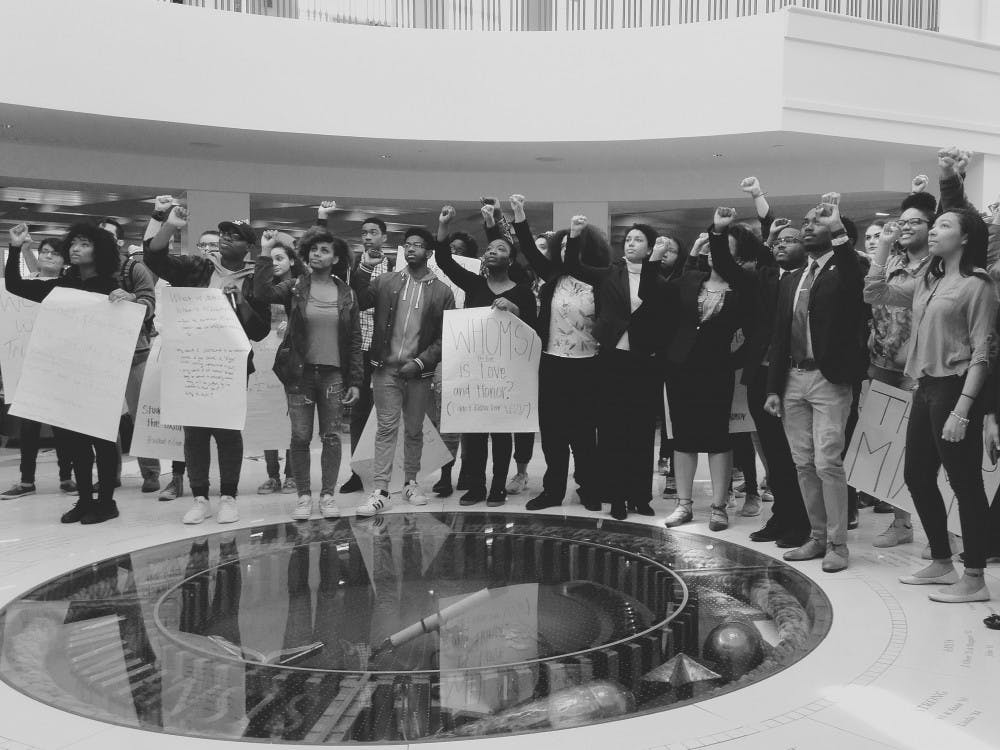Miami University President Gregory Crawford and other top administrators met with student leaders from the Black Action Movement (BAM) 2.0 in a closed-door session Friday morning.
Both groups felt that progress was made in addressing several of the deadlined demands put out by BAM 2.0 on Tuesday, April 3. The publication of the demands followed a week of protests organized by the group after a student used a racial slur in a GroupMe message last semester and then boasted about the incident in Tinder exchange this past spring break. The Friday meeting was, itself, one of the ten demands.
"The meeting on Friday was very, very productive," Crawford said in a phone interview. "I'm so thankful we have such wonderful and passionate students."
Dean of Students Mike Curme, VP of Institutional Diversity Ron Scott, VP of Student Affairs Jayne Brownell and Office of Diversity Affairs (ODA) director Kelly Kimple accompanied Crawford to the meeting.
Administrators said they would work with student activists on some of the demands: updating the student code of conduct, making the avenues for reporting racist and other types harmful incidents more accessible, looking at the numbers for a new ODA building and developing some kind of racism-specific adjudication process to handle racist incidents in the future.
The fastest changes might come to incident reporting. The BAM 2.0 leaders said administrators agreed to add a button on the Quick Tools section of MyMiami (where the Canvas and BannerWeb buttons are located) that would take students to a page that would point them toward different processes for reporting harmful incidents.
But some of the demands, particularly the quotas for minority faculty and students, the administrators said, weren't feasible requests.
"Personally I just liked the fact that the administration was open with us. They were transparent and they told us what can be done and what is going to be done to replace what wasn't necessarily possible," said Jermaine Thomas, a sophomore and one of the BAM 2.0 leaders at the meeting.
Thomas was joined by other BAM 2.0 student leaders Kyra Germany, Jaylen Perkins, Miranda Woods, Aleah Holley, Imani Steele and Clara Guerra.
Though the activists appreciated the administration's promises to work together, they want to make it clear to the administration that BAM 2.0 will still continue to push on these issues.
"President Crawford, you have a great heart and you want to do great things for the university, but also, we're serious. These demands are not suggestions, they're demands," said Holley. "They're what we see as gaps, and so I think for me the biggest thought was an understanding that even though we're students we're very serious."
While the mood within the closed session was collaborative, the feelings of the activists outside the room were more pointed.
Enjoy what you're reading?
Signup for our newsletter
The meeting was held in ODA, a space sometimes criticized by the students that spend time there for the fishbowl effect of its floor-to-ceiling glass walls and visible location on the first floor of Armstrong -- right along the path of tour groups.
But on Friday, BAM 2.0 turned those aspects of the office to their advantage.
BAM 2.0 "field organizers," as junior Aleah Holley described them, papered the glass walls with handmade posters and signs as the meeting drew on inside.
But rather than pointing out toward the rest of Armstrong, most of the messages were taped up with their messages aimed at the administrators sitting inside.
Directly across from where Crawford and Scott sat, one student hung a sign that read "We're not paying you $400,000 a year to do this bad of a job, DO BETTER GREG & RON SCOTT!"
Other signs decried institutional racism and called for action over talk. A few copies of the front page of the Cincinnati Enquirer were also taped up. The headline of the centerpiece story read "Racist acts fuel MU student movement."
The roughly two-dozen students who were involved in making and posting signs also turned their attention to the throngs of Make It Miami attendees that flowed down the staircase near the seal. Most of the prospective students and Miami parents ignored the activists, who stood silently in a row with signs, but some lingered. The biggest poster displayed a repeated theme of last two weeks of activism: "This is Miami."
This two-pronged approach of collaborative discussion backed up by continued demonstrations represents the path forward for BAM 2.0, said the group's leaders. Junior Miranda Woods summed it up as "constant applied pressure."
"This is just the beginning," she said.
For the full list of BAM 2.0's demands and recent coverage on activism at Miami, visit miamistudent.net




